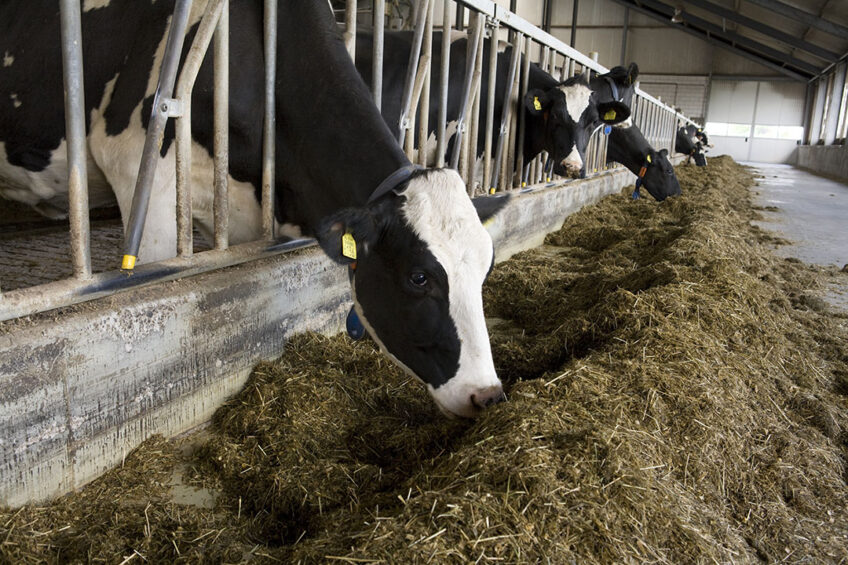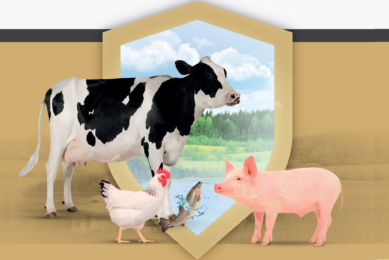Emerging, masked mycotoxins pose threats to livestock

Trouw Nutrition shares insights into the challenges posed by mycotoxins in feed ingredients and the risks of emerging mycotoxins and masked mycotoxins.
As the 2020 harvest season gets underway in the northern hemisphere, Trouw Nutrition, a Nutreco company, is sharing information regarding the challenges posed by mycotoxins in feed ingredients, while highlighting the risks of emerging mycotoxins and masked mycotoxins. Amid the threats posed by mycotoxins, a holistic approach including testing, farm management and the use of feed additives may help support livestock production. The information was presented in the webinar ”Mycotoxin interaction: An open challenge to global animal industry”, part of Trouw Nutrition’s global webinar series.

Even prior to the global pandemic bringing an increased focus to safety throughout the food chain, feed safety awareness was driving innovations to counter safety threats.
This heightened focus on safety means that companies with food safety challenges from contaminants including mycotoxins, heavy metals, pesticides, or antibiotic residues put the reputation of their organisations at risk. Mycotoxins can present food safety challenges to animals and humans through the contamination of grains, animal products and by-products. Several issues with toxin contamination, including aflatoxin M1 presence in milk, ochratoxin A in kidney and pork products and T-2 toxin in eggs, have been reported in different parts of the world.
Mycotoxin presence and challenges
Mycotoxins are a secondary metabolite generated by several types of mould. The majority of agricultural commodities – or raw ingredients used in feed – are contaminated with some level of mycotoxins. They can be found in grains and protein sources, such as soybean meal and rapeseed meal. Mycotoxins also can be concentrated in by-products of agricultural commodities like DDGS, rice bran and wheat bran. The toxins tend to be highly stable, remaining in feed after pelleting or extrusion during the manufacturing process.

Click here to enlarge this figure
Currently, there are more than 600 known types of mycotoxins and feed materials can host more than one type simultaneously. Common moulds that generate mycotoxins include Aspergillus, Claviceps, Penicillium and Fusarium. However, presence of specific mycotoxins may vary by region. In North America and Europe, Fusarium graminearum, which produces deoxynivalenol (DON) and zearalenone are common, while in South America and Africa, fumonisins may be more prevalent. In Asia, aflatoxin and fumonisin can be common challenges. However, countries that import feed grains also can bring in non-regional mycotoxins.
Though testing for all types of mycotoxins would practically be impossible, it is well-known that mycotoxins pose various animal health and performance risks, as well as an increased feed cost, due to the need for more analysis and increased regulatory pressure.
Industry opinion is that regulatory and guidance levels of mycotoxin inclusion are higher than what animals can actually manage. Limits were established looking at results from individual toxins and were not based on the more realistic understanding that feeds can include contamination from multiple mycotoxins. Higher levels of toxicity are anticipated when more than one mycotoxin is present.
 Maize: Ensure an airtight seal in the clamp
Maize: Ensure an airtight seal in the clamp
Maize silage is a high energy crop especially suitable for demanding cows but it can be an expensive forage to produce if not ensiled properly.
Global warming and mycotoxin levels
The amount of a mycotoxin found in a feed ingredient can vary year to year based on conditions and rainfall during growth and harvest. Mycotoxins like DON can be influenced by heavy rain during the silking period for maize, while drought during growth stages can alter the expression of aflatoxin or fumonisin.
Annual variations in mycotoxin levels make it harder to answer the question of whether mycotoxin levels are on the rise. A trend of increasing occurrence is being linked to global warming, unseasonal rains and flooding.
Testing for mycotoxins
The understanding that multiple types of mycotoxins can be present in an ingredient or complete feed raises questions regarding if testing is necessary and, if so, how much testing is needed. There are a range of mycotoxin tests available – some highlight 6 primary types of mycotoxins, while other tests look for 50 or 300 different varieties. When the “Big 6” mycotoxins – aflatoxin B1, ochratoxin A, T-2 toxin, DON, fumonisin and zearalenone – are present, there is an understanding that another 30 or 40 mycotoxins may also be in that ingredient. In previous testing, for example, the presence of DON corresponded to co-contamination by zearalenone about 90% of the time.
 How to mitigate feed safety risks in ruminant diets
How to mitigate feed safety risks in ruminant diets
While ruminants are well-designed to leverage the feed-to-food upcycling trend, production efficiency can never come at the expense of safety.
Although one approach is to always test for as many toxins as possible, another perspective is to consider how quickly the information is needed and how the results are being interpreted. If tests are being conducted at the feed mill and results are needed quickly, it may make more sense to complete a rapid test for the 6 primary mycotoxins and to save more thorough testing for situations where is there is a concern about a complete feed or if animals develop symptoms indicating a mycotoxin challenge.
If no major mycotoxins are found in an ingredient, it may be premature to assume an ingredient is safe. Additional factors, including how the tested sample was collected, the presence of below-quantification levels of mycotoxins, levels of untested toxins and masked mycotoxins, need to be considered.
Evaluating emerging mycotoxins
Increasingly, attention is being paid to emerging mycotoxins or mycotoxins that are not often analyzed or regulated.

Click here to enlarge this figure
Several of these types of mycotoxins may not be able to be commercially analyzed at this time. However, they are increasingly being reported and found in industry surveys. One mycotoxin that is gaining increased attention in this fashion is moniliformin, which is generated along with fumonisin. In addition, some forms of known mycotoxins potentially require additional examination. Although not considered to be emerging because they are well-known, questions remain about their influence. Several of these toxins – such as ochratoxin B or 3-acetyl DON – are related to identified mycotoxins.
Emerging danger: Masked mycotoxins
In addition to emerging mycotoxins, awareness of masked mycotoxins is becoming more prevalent, and research on the topic is expanding in regions including North America and Europe. Masked mycotoxins are mycotoxins that have been through glucosylation, meaning they have an attached glucose molecule. The first masked mycotoxin detected was zearalenone-14-glucoside.
The glucose molecule is added to the toxin by the plant, which is seeking to reduce mycotoxin concentration and reduce its toxicity. The hidden toxins have been found in multiple countries and regions, including the U.S., South America, South Africa, China, Japan, the Middle East and throughout Europe.

Click here to enlarge this figure
The presence of hidden or masked mycotoxins presents a risk for producers, because when feed ingredients with masked mycotoxins are harvested, the altered toxin remains in the collected grain or plant. After the material is eaten and broken down in the intestinal tract, the mycotoxin is released from the glucose and can regain its previous toxicity. Although the toxin was not found in initial testing, the mycotoxin is released within the animal and increases the amount of mycotoxin available to damage cells and organs and move into blood circulation. Once broken down by the animal, a feed with 2ppm DON could increase in toxicity to have 4ppm DON – twice the level determined in initial testing. This transformation from hidden to toxic may be what prompts animals on a diet with relatively lower mycotoxin levels to present symptoms of mycotoxin presence in feed.
DON-3-glucoside (DON-3G) is one of the more well-studied versions of masked mycotoxins. It has been found in maize, wheat and barley, and can be present at up to 100% of the level of DON in the plant. Amounts of masked toxins are not yet determinable through commercial analysis. However, the EU is working on establishing testing for select masked mycotoxins.

Click here to enlarge this figure
Regulatory agencies including EFSA, the U.S. FDA and the Joint FAO/WHO Expert Committee on Food Additives (JECFA) are starting to pay more attention to levels of masked mycotoxins in feed and food. Going forward, this effort may need to be expanded to identify and address additional masked mycotoxins. EFSA and JECFA are considering or adding some known masked mycotoxins, like DON-3G, to the total DON level that can be present in feed.
Multiple mycotoxin presence and 3 primary interactions
Another feed safety factor to consider is how many different mycotoxins are present in the ingredient or feed, and how those toxins interact. In a survey completed in 2019 by researchers in Austria looking at 10 years of samples from 100 countries, 88% of samples had at least one mycotoxin and 64% contained 2 or more. The survey focused on finding the “Big 6” mycotoxins; the most common mixtures located were DON, zearalenone and fumonisin or aflatoxin and fumonisin.
Similarly, a study in 2020 done by researchers in Ireland looking at mycotoxin numbers in broiler feeds in Northern Ireland and tracking 24 toxins found that 22 mycotoxins were present in half the feeds tested. 7 mycotoxins were found in every feed.
 Mycotoxin Analysis: 90% of samples show presence of DON
Mycotoxin Analysis: 90% of samples show presence of DON
Trouw Nutrition, a Nutreco company, recently released findings from the 2019 Global Mycotoxin Risk Analysis in a live webinar.
There are 3 primary ways for mycotoxins to interact when multiple types are found in one feed. When combined, mycotoxins can be additive, synergistic or antagonistic.
In additive interactions, the influence of one toxin builds off of another. For example. if the presence of each mycotoxin individually corresponded to 100g of bodyweight loss in a species, having both could mean 200g of loss. In a synergistic pairing, the presence of the 2 mycotoxins – such as DON and fusaric acid – might result in 250g of body weight loss or a non-toxic element becoming toxic. The combination produces results that are greater than what might have been anticipated if either mycotoxin is fed singly. In this case, negative consequences are actually greater than the sum of the individual mycotoxins. However, during an antagonistic interaction – like that seen between DON and ochratoxin – the negative response for the animal is reduced and there might be 150g of weight loss. In this situation, one of the mycotoxins tends to reduce the toxicity of another, increase its excretion or block its effect.
Another challenge stemming from the interaction among multiple mycotoxins is that, if the threat is not detected, it can be hard to diagnose from animal reactions leading to no corrective action. Such complacence can, in turn, lead to reduced performance and economic losses for the producer.
 6 tips for supporting ruminant feed safety
6 tips for supporting ruminant feed safety
High quality ruminant feed is essential to the business of producing safe dairy protein. Below, we look at 6 tips for supporting ruminant feed safety.
Feeding and mitigation efforts
A crucial element in the discussion of mycotoxins remains addressing the challenge present. A complex, management-based approach may be needed to mitigate the widest range of effects. Potential steps include confirming the origin of raw materials, inspecting raw material supplier facilities, monitoring raw material transportation conditions, having quality control practices in place, ensuring feed mill storage sites are clean and dry, and correctly using a mould inhibitor with stored feed ingredients.
Also, inspecting conditions at the feed mill, managing feed flow and providing optimum nutrition play a role in the integrated management process. Adding a toxin binder to feed can help, as can use of supplemental amino acids, antioxidants or other immune modulators. Unlike feed additives intended to reduce the amount of mycotoxins in a feed, immune-stimulating ingredients help protect animals or aid recovery following exposure.
In a Trouw Nutrition trial conducted in conjunction with researchers in Italy, dairy cows were provided feed containing a low level of aflatoxin for 18 days. By the second day of the trial, a notable increase in the amount of aflatoxin was found in the cows’ milk, and by day 4 of the trial the levels found reached 70 nanograms per kilogram in milk, exceeding EU regulatory limits. However, the addition of a bentonite clay mycotoxin binder was able to reduce levels of mycotoxin expressed in milk throughout the length of the trial.

Click here to enlarge this figure
Mycotoxins are complex and challenging issues that present a global food safety and health hazard for production species and people. Feed ingredients tend to include more than one type of mycotoxin, some of which demonstrate increased toxicity when combined. Ongoing mycotoxin analysis efforts are improving understanding of threats posed by emerging and masked mycotoxins. Increased understanding of mycotoxin interactions and the amounts present in feed can help producers take effective mitigation steps.
At Trouw Nutrition, addressing mycotoxins starts with rapid testing done at the feed mill to provide a species-specific risk analysis for producers. Information can be used to provide a complete feed risk report, which may suggest steps such as reformulating feed. The company also maintains a product line that includes methods of adsorbing or binding mycotoxins, aids to improve gut wall protection and ingredients to support the immune system.
“There is no doubt that mycotoxins will continue to be a food safety hazard in the coming years,” said Swamy Haladi, Global Programme manager Mycotoxin Risk Management at Trouw Nutrition. “Co-occurrence is a rule and not an exception. We all have to accept that.”
“We are understanding more about emerging and masked mycotoxins,” he added. “We are understanding the total toxicity threat posed to the animals. By knowing the total toxicity, I think we will become more proactive in taking prevention and control measures.”
References available on request.
Join 13,000+ subscribers
Subscribe to our newsletter to stay updated about all the need-to-know content in the dairy sector, two times a week.










